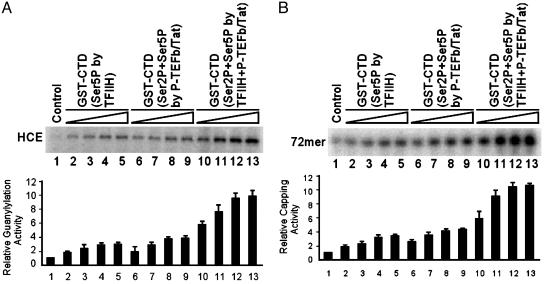Fig. 3.
Additive effects of CTD phosphorylation sequentially by TFIIH and Tat-induced P-TEFb on the stimulation of the GT activity of HCE and RNA cap formation. (A) Stimulation of the GT activity of HCE. Guanylylation of HCE was performed by incubating HCE with [α-32P]GTP in the absence (lane 1) or presence of bead-bound GST-CTD phosphorylated by TFIIH (lanes 2–5), P-TEFb/Tat (lanes 6–9), or sequentially by TFIIH and P-TEFb/Tat (lanes 10–13) and then assessed by SDS/PAGE followed by autoradiography. Quantitation of three independent assays performed under similar conditions is shown at the bottom of the panel. (B) Stimulation of RNA cap formation. Transfer of GMP to RNA was performed by incubating RNA with HCE and [α-32P]GTP in the absence (lane 1) or presence of bead-bound GST-CTD phosphorylated by TFIIH (lanes 2–5), P-TEFb/Tat (lanes 6–9), or sequentially by TFIIH and P-TEFb/Tat (lanes 10–13) and then analyzed by electrophoresis through 10% polyacrylamide gels containing 7 M urea in TBE buffer followed by autoradiography. Quantitation of three independent assays performed under similar conditions is shown below.

